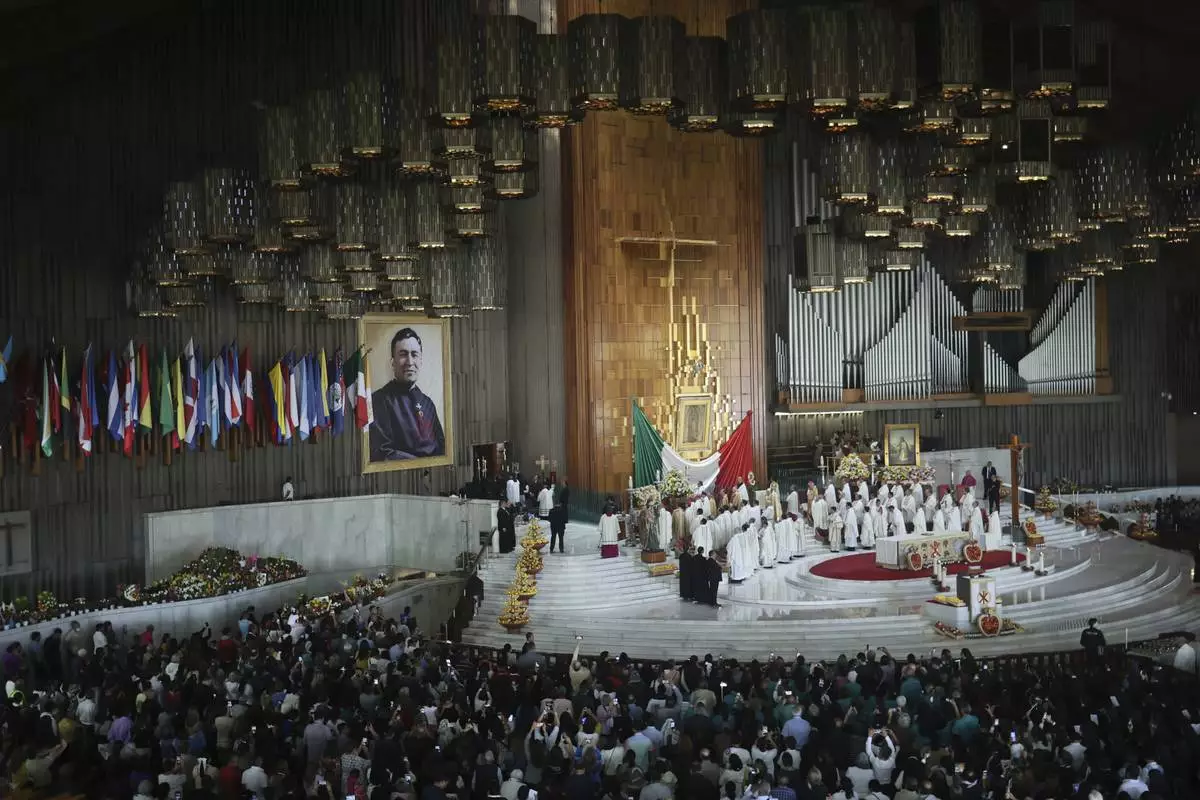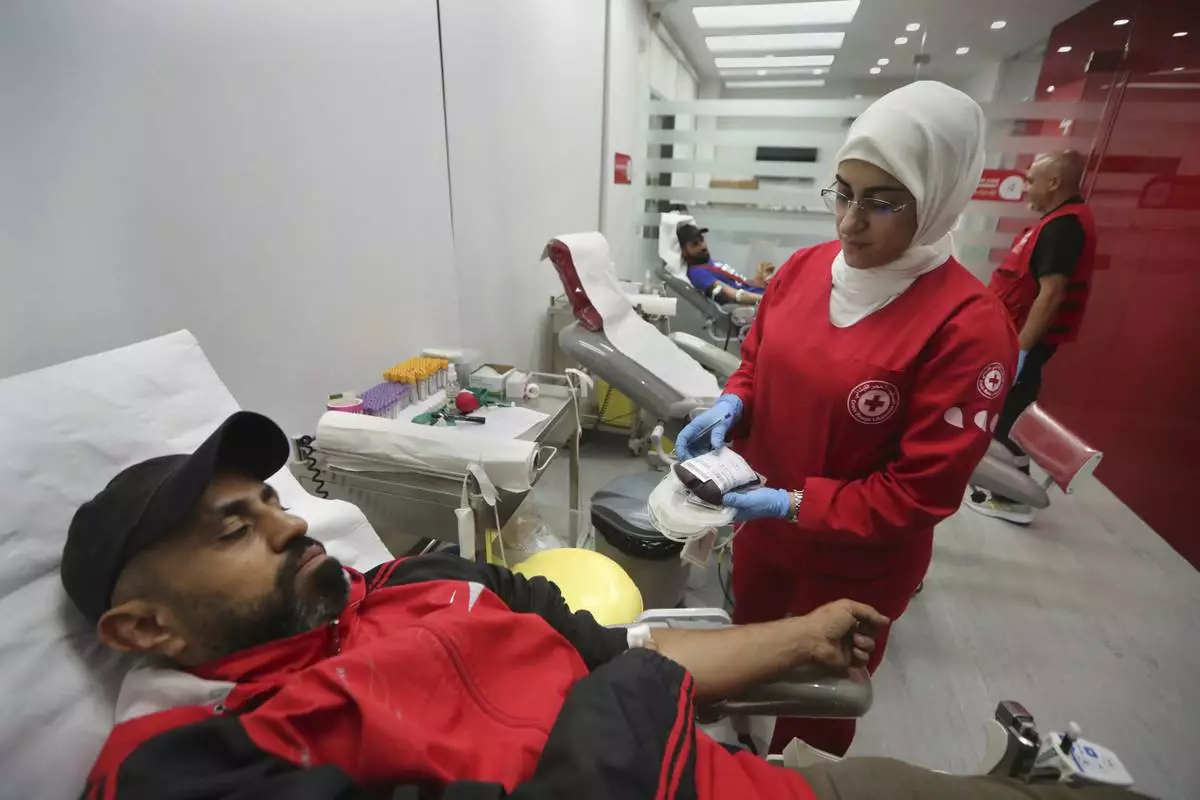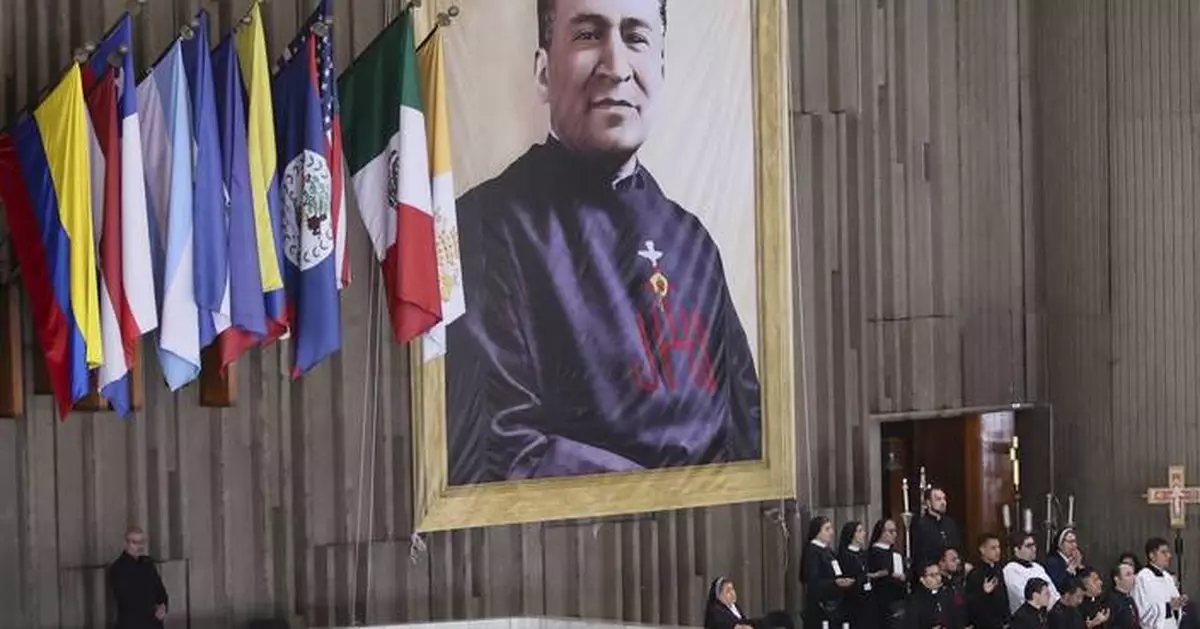MEXICO CITY (AP) — Mexico’s Catholic Church is getting a new addition to its ranks of “blessed,” with the beatification of the Rev. Moisés Lira.
The beatification ceremony was taking Saturday at Our Lady of Guadalupe’s Basilica, led by Cardinal Marcello Semeraro, who was appointed by Pope Francis for the occasion.
Before Lira, the latest Mexican to be beatified was María Concepción Cabrera in 2019.
Here’s a look at Lira’s life in a country that’s home to nearly 100 million Catholics.
He was born in September 1893 in Puebla, one of Mexico’s most conservative states.
His mother died when he was 5 and he suffered the absence of his father, who had to relocate for work.
Lira dreamt of becoming a priest from a young age. In 1914, he became the first novice of a congregation founded by French priest Félix de Jesús Rougier. And in 1922, after being ordained a priest, he wrote the motto that would define his life: “It is necessary to be very small to be a great saint.”
Lira devoted his life to teach catechists, care for the ill and offer spiritual guidance to vulnerable communities. In 1934, he founded a congregation — the Missionaries of Charity of Mary Immaculate — as well as schools and psychiatric institutions.
He died in Mexico City in 1950.
According to Mother María de la Luz Nava, from the congregation founded by Lira, the miracle took place between May and June 2004.
Back then, a pregnant woman from Guanajuato — another of Mexico’s conservative states — got the worst news imaginable: at 18 weeks of gestation, her unborn daughter suffered from a condition characterized by accumulation of fluid.
The diagnosis, the doctor said, could be fatal for the fetus or affect the mother. And though he offered to terminate the pregnancy, the woman and her husband refused.
“There wasn’t much hope,” Mother María de la Luz said. “But they were very clear about one thing: they were not going to opt for abortion. They were going to continue looking for options so that their daughter would be born well.”
Back home, the woman found a brochure on the Rev. Lira’s work. “I don’t know you,” she told him. “But please, help me.”
For nine days, she prayed. And when a new doctor’s appointment came, a surprise awaited.
“What did you do?” the doctor asked the couple. “Because your daughter is healthy.”
“This is where the intercession of Father Moisés is very evident,” said Mother María de la Luz. “And it shows how a miracle is produced by faith.”
De la Luz's congregation learned about the case in 2014. The beatification request was made through the local diocese the following year and eight years passed until Pope Francis issued a decree for the miracle in 2023.
According to the Rev. David Padrón, who has worked on causes for canonization, the miracle attributed to Lira makes him a protector of life from conception.
“This is a very strong message from God,” Padrón said. “Maybe those mothers who have a problem during their pregnancies can confide in him.”
Aside from that, he said, parishioners could also entrust him with health and education causes, because Lira worked extensively with sick people and students.
“Much of his pastoral work dignified those who, due to illness, poverty or some other situation, did not enjoy a dignified life in society,” Padrón said.
Catholic leaders trust that a second miracle would be produced after Saturday’s beatification, which would allow them to pursue Lira's canonization.
In the meantime, local parishes will honor him each June 15. “We have included him as part of the saints of the Archdiocese of Mexico, hoping that, when he is canonized, he can be celebrated throughout the world,” Padrón said.
Lira’s most treasured relic is a metacarpal bone from his right hand. It’s symbolic, Padrón said, because Lira shared the Gospel through his writings and it’s part of the pointing finger.
“The blessed and the saints are men and women who point us to Christ,” he said.
A few first-class relics — body parts of Lira — will be soon distributed through parishes that were significant in his life or for Mexico’s Catholic community, such as Our Lady of Guadalupe’s Basilica and Puebla’s cathedral.
Associated Press religion coverage receives support through the AP’s collaboration with The Conversation US, with funding from Lilly Endowment Inc. The AP is solely responsible for this content.

Nuns arrive for the beatification ceremony of Rev. Moisés Lira at the Basilica of Our Lady of Guadalupe in Mexico City, Saturday, Sept. 14, 2024. (AP Photo/Ginnette Riquelme)

Cardinal Marcello Semeraro presides over the beatification ceremony of Rev. Moisés Lira at the Basilica of Our Lady of Guadalupe in Mexico City, Saturday, Sept. 14, 2024. (AP Photo/Ginnette Riquelme)

Cardinal Marcello Semeraro presides over the beatification ceremony of Rev. Moisés Lira at the Basilica of Our Lady of Guadalupe in Mexico City, Saturday, Sept. 14, 2024. (AP Photo/Ginnette Riquelme)

A portrait of Rev. Moisés Lira hangs at the Basilica of Our Lady of Guadalupe during his beatification ceremony in Mexico City, Saturday, Sept. 14, 2024. (AP Photo/Ginnette Riquelme)
NEW YORK (AP) — In what appears to be a sophisticated, remote attack, pagers used by hundreds of members of Hezbollah exploded almost simultaneously in Lebanon and Syria Tuesday, killing at least 12 people — including two children — and wounding thousands more.
A U.S. official said Israel briefed the U.S. on the operation — in which small amounts of explosive hidden in the pagers were detonated — on Tuesday after it was concluded. The person spoke on the condition of anonymity because they were not authorized to discuss the information publicly.
The Iran-backed militant group blamed Israel for the deadly explosions, which targeted an extraordinary breadth of people and showed signs of being a long-planned operation. Details on how the attack was executed are largely uncertain and investigators have not immediately said how the pagers were detonated. The Israeli military has declined to comment.
Here's what we know so far.
Hezbollah leader Hassan Nasrallah previously warned the group’s members not to carry cellphones, saying they could be used by Israel to track the group's movements. As a result, the organization uses pagers to communicate.
A Hezbollah official told The Associated Press the exploded devices were from a new brand the group had not used before. The official, who spoke on condition of anonymity because he was not authorized to talk to the press, did not identify the brand name or supplier.
Taiwanese company Gold Apollo said Wednesday it had authorized use of its brand on the AR-924 pager model and a Budapest, Hungary-based company called BAC Consulting produced and sold the pagers. Further information on BAC wasn't immediately available.
Nicholas Reese, adjunct instructor at the Center for Global Affairs in New York University’s School of Professional Studies, said smart phones carry a higher risk for intercepted communications in contrast to the simpler technology of pagers.
This type of attack will also force Hezbollah to change their communication strategies, said Reese, who previously worked as an intelligence officer, adding that survivors of Tuesday's explosions are likely to throw away "not just their pagers, but their phones, and leaving their tablets or any other electronic devices.”
Even with a U.S. official confirming it was a planned operation by Israel, multiple theories have emerged Tuesday around how the attack might have been carried out. Several experts who spoke with The Associated Press explained how the explosions were most likely the result of supply-chain interference.
Very small explosive devices may have been built into the pagers prior to their delivery to Hezbollah, and then all remotely triggered simultaneously, possibly with a radio signal.
By the time of the attack, “the battery was probably half-explosive and half-actual battery," said Carlos Perez, director of security intelligence at TrustedSec.
A former British Army bomb disposal officer explained that an explosive device has five main components: A container, a battery, a triggering device, a detonator and an explosive charge.
“A pager has three of those already,” said the ex-officer, who spoke on condition of anonymity because he now works as a consultant with clients on the Middle East. “You would only need to add the detonator and the charge.”
After security camera footage appeared on social media Tuesday purporting to show one of the pagers exploding on a man’s hip in a Lebanese market, two munitions experts offered opinions that corroborate the U.S. official's statement that the blast appeared to be the result of a tiny explosive device.
“Looking at the video, the size of the detonation is similar to that caused by an electric detonator alone or one that incorporates an extremely small, high-explosive charge,” said Sean Moorhouse, a former British Army officer and explosive ordinance disposal expert.
This signals involvement of a state actor, Moorhouse said. He adds that Israel’s foreign intelligence agency, the Mossad, is the most obvious suspect to have the resources to carry out such an attack.
N.R. Jenzen-Jones, an expert in military arms who is director of the Australian-based Armament Research Services, notes that Israel had been accused of carrying out similar operations in the past. Last year, AP reported that Iran accused Israel of trying to sabotage its ballistic missile program through faulty foreign parts that could explode, damaging or destroying the weapons before they could be used.
It would take a long time to plan an attack of this scale. The exact specifics are still unknown, but experts who spoke with the AP shared estimates ranging anywhere between several months to two years.
The sophistication of the attack suggests that the culprit has been collecting intelligence for a long time, Reese said. An attack of this caliber requires building the relationships needed to gain physical access to the pagers before they were sold; developing the technology that would be embedded in the devices; and developing sources who can confirm that the targets were carrying the pagers.
And it's likely the compromised pagers seemed normal to their users for some time before the attack. Elijah J. Magnier, a Brussels-based veteran and a senior political risk analyst with over 37 years experience in the region, said he has had conversations with members of Hezbollah and survivors of Tuesday's pager attack. He said the pagers were procured more than six months ago.
“The pagers functioned perfectly for six months," Magnier said. What triggered the explosion, he said, appeared to be an error message sent to all the devices.
Based on his conversations with Hezbollah members, Magnier also said that many pagers didn’t go off, allowing the group to inspect them. They came to the conclusion that between 3 to 5 grams of a highly explosive material were concealed or embedded in the circuitry, he said.
Jenzen-Jones also adds that “such a large-scale operation also raises questions of targeting" — stressing the number of causalities and enormous impact reported so far.
“How can the party initiating the explosive be sure that a target’s child, for example, is not playing with the pager at the time it functions?” he said.
Associated Press journalist Johnson Lai in Taipei contributed to this report.

People donate blood for those who were injured by their exploded handheld pagers, at a Red Cross center, in the southern port city of Sidon, Lebanon, Tuesday, Sept. 17, 2024. (AP Photo/Mohammed Zaatari)














